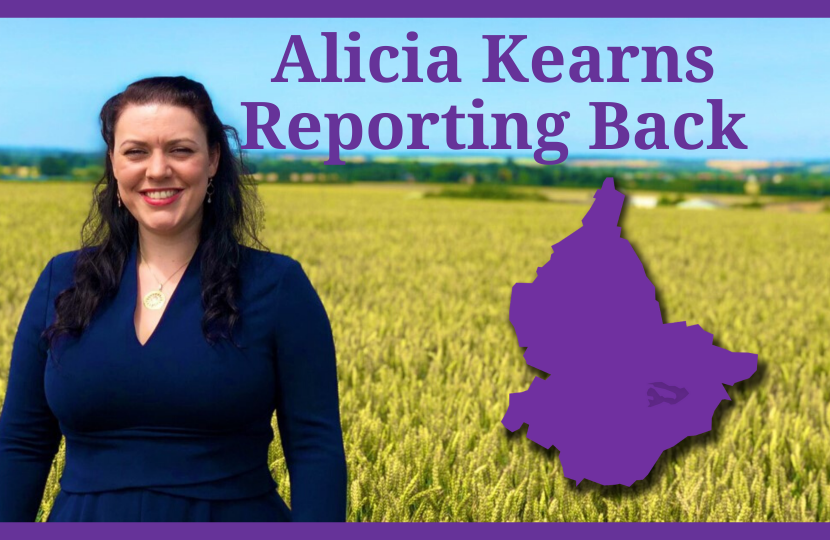
Today the Prime Minister laid out the Government's plan for how we move forward. This afternoon the Government published the official recovery strategy and I am writing this to summarise the three- staged strategy of how our country will heal from COVID-19 and to provide a detailed Government guide and Q&A documents which I hope you will find very useful.
Thank to your sacrifices, we have begun to turn the tide in our fight against the virus, but we still have a long way to go. As time passes we will learn more about how to manage and defeat the virus, but it is crucial that we proceed with caution. This means we cannot afford to make drastic changes in the near-term.
Over the next weeks and months as we move through these three stages restrictions will be gradually adjusted so our lives can return to a form of normality, but the Government’s five tests will be closely monitored and if the data suggests the virus is spreading again, the Government will have to tighten restrictions, possibly at short notice.
There are two key documents I recommend reading:
The Government’s full guidance
The Q&A document
As we go forward at every stage there will be developments and adjustments, beyond just larger updates such as that given today. I would urge you to watch the daily press conferences and to rely on Government updates.
I am confident that Rutland and Melton's residents will be exemplary citizens in adhering to adjusted restrictions and remaining alert to the threat of COVID-19.
STEP ONE
Work: For the foreseeable future, those who are able to work from home should continue doing so, however, all workers who cannot work from home are now encouraged to travel to their work if their workplace is open (Government guidelines on which industries can open will gradually be announced). Social distancing should be upheld wherever possible and you are encouraged not to use public transport if possible.
It remains the case that anyone who has symptoms, however mild, or is in a household where someone has symptoms, should not leave their house to go to work. Those people should self-isolate, as should those in their households.
Schools: The rate of infection remains too high to allow all pupils to return to school yet, but it is important that vulnerable children and the children of critical workers are able to attend school, as is currently permitted.
Travel: Everybody (including critical workers) should continue to avoid public transport wherever possible. The Government will increase funding and provide new guidance for local authorities to widen pavements, create pop-up cycle lanes, and close some roads in cities to traffic (apart from buses) to ensure more people can travel by bicycle or by foot. Those who do take public transport should follow social distancing guidance rigorously.
Public spaces: SAGE has advised that the risk of transmission is significantly less outside than inside, so the Government is updating the rules so that as well as exercise, people can now also spend time outdoors subject to:
- Not meeting up with any more than one person from outside your household.
- Continued compliance with social distancing guidelines to remain 2 metres (6 feet) away from people outside your household.
- Good hand hygiene (particularly with respect to shared surfaces).
- Those responsible for public places being able to put appropriate measures in place to follow the new COVID-19 Secure guidance.
From Wednesday 13th May, people may exercise outside as many times a day as they wish and drive to outdoor open spaces irrespective of distance provided all social distancing guidelines are scrupulously followed. This does not mean travelling to second homes. In time the PM hopes to allow households to match and mix between two households, but we are not there yet.
The infection rate will increase if people begin to break these rules and, for example, mix in groups in parks, which will trigger the need for further restrictions.
Face Coverings: Due to the increased mobility resulting from the adjusted restrictions, we are advising that people should aim to wear face-coverings in enclosed spaces where social distancing is not always possible and they come into contact with people they do not normally meet (e.g. public transport or some shops). Homemade face cloths will reduce the risk of transmission by the wearer.
It is important to note that a face covering is not the same as a face mask such as those used by our health and care workers.
Protecting the Vulnerable: The clinically vulnerable should continue to take particular care to minimise contact with others outside their household, but do not need to be shielded. Those in the extremely vulnerable group are strongly advised to stay at home at all times and avoid any face to face contact (shielding).
Enforcement: We are examining more stringent enforcement measures for non-compliance and will impose higher fines to reflect the increased risk to others of breaking the rules as people are returning to work and school. I asked a question about this to the Prime Minister today which you can watch HERE.
International Air Travel: I have been pushing for tougher restrictions. The Government will require all international arrivals not on a short list of exemptions to self-isolate in their accommodation for fourteen days on arrival to the UK. Where international travellers are unable to demonstrate where they would self-isolate, they will be required to do so in accommodation arranged by the Government. We will also require all international arrivals to supply their contact and accommodation information, strongly advising them to download and use the NHS contact tracing app. These restrictions will be in place as soon as possible, but not on Wednesday.
STEP TWO
The content and timing of the second stage of adjustments will depend on the most up-to-date assessment of the risk posed by the virus and our progress in meeting the five tests established last month.
The adjustments will be made possible by continued national compliance with restrictions and expanding our test and trace capabilities.
The absolute earliest any step two adjustments will be made is Monday 1st June, and we hope to include as many of the possible as following, subject of course to the five tests.
Social Contact: As restrictions continue, we will consider a range of options to reduce the most harmful social effects to make the measures more sustainable.
For example; the Government has asked SAGE to examine whether, when and how it can safely change the regulations to allow people to expand their household group to include one other household
In addition, the Government is also examining how to enable people to gather in slightly larger groups to better facilitate small weddings.
Over the coming weeks, the Government will engage on the nature and timing of the measures in this step, in order to consider the widest possible array of views on how best to balance the health, economic and social effects.
Schools: A phased return for early years settings, and Reception, Year 1 and Year 6 to return to school in smaller sizes.
This aims to ensure that the youngest children, and those preparing for the transition to secondary school, have maximum time with their teachers. Secondary schools and further education colleges should also prepare to begin some face to face contact with Year 10 and 12 pupils who have key exams next year, in support of their continued remote, home learning.
I know many parents are worried about this, and as a mother of a young child I understand this. We are a long way off this as yet, and when children return to school, the school environment will be very different. Specific guidance will be published for schools ahead of any re-opening.
Non-essential retail: Will be opened in phases when and where it is safe to do so, subject to retailers being able to follow the new COVID-19 Secure guidelines.
All other sectors that are currently closed, including hospitality and personal care, are not expected to be able to re-open at this point because the risk of transmission in these environments is higher.
Cultural and sporting events: Will be broadcast but not attended in person to avoid large-scale social contact.
STEP THREE
Step three will begin when the assessment of risk allows further adjustments to the remaining measures. We assume this will be no earlier than July 4th and remains subject to the five tests enabling some or all of the measures below.
The ambition is to open at least some of the remaining businesses and premises that have been required to close, including; personal care (e.g. hairdressers), hospitality (e.g. pubs), public places (e.g. places of worship) and leisure facilities (e.g. cinemas) subject to their ability to meet COVID-19 Secure guidelines which will be provided to businesses.
Some venues which are crowded by design may only be able to re-open partially or not at all at this stage.


